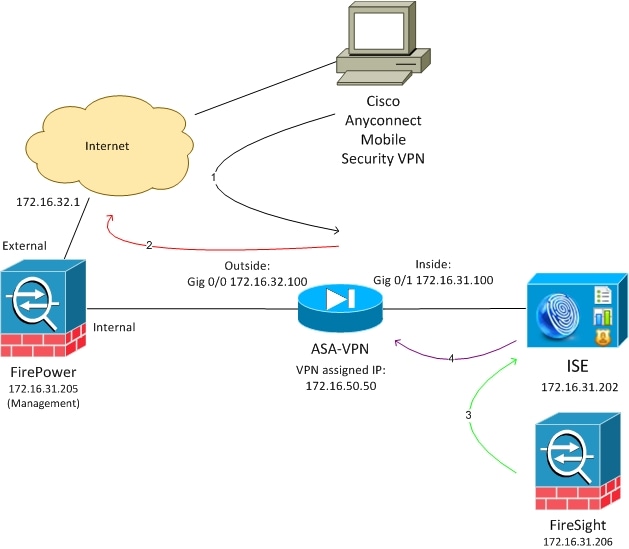KB ID 0001155
Problem
To be honest it’s probably a LOT easier to do this with Dynamic Access Policies, but hey, if you have ISE then why not use it for RADIUS, and let it deploy downloadable ACL’s to your remote clients and give them different levels of access, based on their group membership.
I’m going to keep things simple, I will have a group for admins that can access anything, and a group for users that can only RDP to internal servers.
Cisco ISE and Remote Access VPN question Company Acme wants to use ISE to authenticate against their VPN. They have different connection profiles for different access. ISE was already deployed for simple VPN authentication so, first of all, I had to make a decision on what to use: ASA host scan (requires ASA APEX license) or ISE posture assessment. Great feature comparison here but if it comes down to price then it is about $10 versus $7 per user for ASA vs ISE.
I always assume things will break, so I’m also going to create a local user on the ISE deployment, so if Active Directory is down I will have a user account I can use to gain full access in the event of an emergency.
Solution
In production you will have plenty of users, but to test Im going to create a test user, and a test admin user.
Then put those users in an appropriate Active Directory security group, (here I’m using VPN-Users and VPN-Admins).
Now you will also need a ‘Tunnel-Group and a matching Group-Policy on the ASA to map the user groups to. That way, when a user connects they can pick the appropriate tunnel group like so;
So what I’ve done is setup AnyConnect and configured it properly, (see article below) then I’ve simply ‘cloned‘ the tunnel group, and group policy to create a VPN-ADMIN and VPN-USERS tunnel-group ,and a group-policy. So my ASA config is as follows;
Create a Local Admin Group in Cisco ISE
On your Cisco ISE Deployment > Identity Management > Groups > Add.
Give the group a name and optional description > Save.
To create an admin user > Administration > Identity Management > Identities > Add.
Create the new admin user > set the password > add the user to the group you create above.
Adding Domain Groups To Cisco ISE
I’m assuming you have joined ISE toActive Directory > To check Administration > Identity Management > External Identity Sources > Ensure the domain is joined and operational.
Groups > Add.
Locate and add the groups you created above.
Add An Active Directory Identity Source Sequence
We need to authenticate against our AD, but we want it to fail back to the ISE local database, (for our local admin). To do that we use and identity source sequence. Administration > Identity Management > Identity Source Sequence > Add.
Give the sequence a name and add your AD and Internal Users.
MAKE SURE you select ‘Treat as if the user was not found and proceed to the next store in the sequence’ > Submit.
Add Cisco ASA to Cisco ISE as a RADIUS Device.
Administration > Network Resources > Network Device Groups > All Device Types > Add.
Add a device GROUP for your ASA(s) > Submit.
Administration > Network Resources > Network Devices > Add.
Add in the ASA > Provide its IP address, and add it to the group you created above > Set a RADIUS Shared Secret > Submit.
The shared secret must be the same on the ASA in the AAA config, like so;
Cisco ISE Create Downloadable Access Control Lists DACL

Policy > Policy Elements > Results > Authorisation > Downloadable ACL’s > Add.
Create an ACL for our VPN-USER group, that will only allow RDP (TCP 3389) > Submit.
Ise Vpn License
Repeat the process to create an ACL that allows everything, (for our VPN-ADMINS) > Submit.
Cisco ISE Create Authorisation Profiles
Policy > Policy Elements > Results > Authorisation > Authorisation Profiles > Add.
Ise Vpn Policy Set
Create a profile for VPN-ADMINS > Set the correct DACL.
Set the advanced attributes > Change to RADIUS.
Vpn Use Proxy
Class-25
Set the OU to equal the group-policy that you want the ASA to apply > Submit.
Create another profile for your VPN-USERS > Set the correct ACL.
RADIUS > Class-25 > OU set to the group-policy on your ASA for the normal users > Submit.
Is Vpn Needed At Home
Cisco ISE Enable Policy Sets
Ise Vpn Policy
Note: only available on newer versions of ISE: Administration > System > Settings > Policy Sets > Enabled > Submit.
Policy > Policy Sets > Add.
Continue to PART TWO
Related Articles, References, Credits, or External Links




